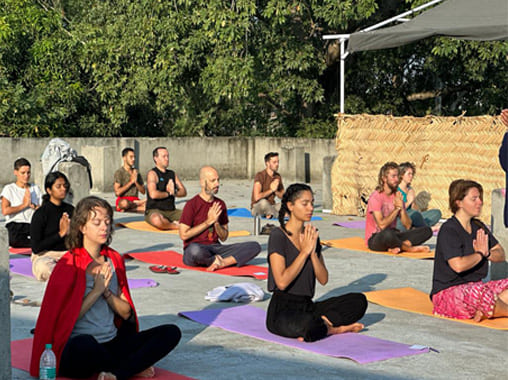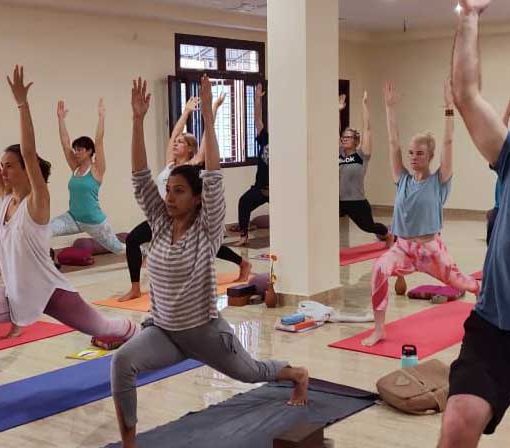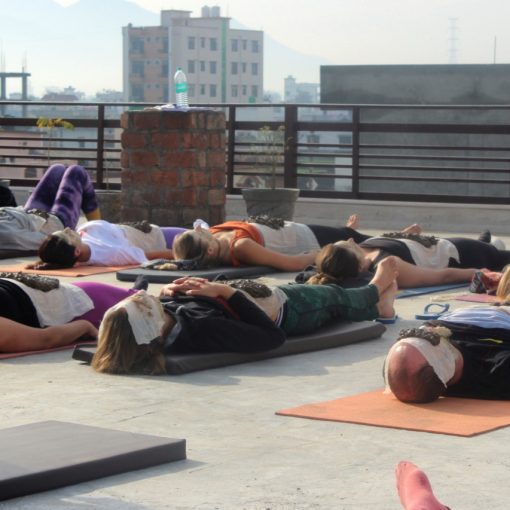Yoga Nidra, often referred to as “yogic sleep,” is a profound meditation and relaxation technique that brings deep rest to the body and mind. Originating from ancient yogic traditions, this practice has gained popularity in recent years for its numerous benefits. In this article, we will explore the concept of Yoga Nidra, its methodology, the benefits it offers, and how to incorporate it into your daily routine.

Introduction to Yoga Nidra
Yoga Nidra is a powerful practice that takes you to a state of deep relaxation while maintaining awareness and consciousness. It is a systematic method of inducing complete physical, mental, and emotional relaxation, helping you access the subconscious mind and tap into your inner potential. Unlike ordinary sleep, where the mind is inactive, Yoga Nidra encourages a state of deep restfulness with heightened awareness.
What is Yoga Nidra?
Yoga Nidra is a Sanskrit term that translates to “yogic sleep.” It is a guided meditation technique that leads you into a state of profound relaxation, similar to the deep relaxation experienced just before falling asleep. However, in Yoga Nidra, you remain conscious throughout the practice, allowing you to explore the layers of your being and gain deep insights.
Historical Background
Yoga Nidra finds its roots in ancient Indian scriptures and yogic texts. It was first mentioned in the “Vigyan Bhairav Tantra,” an ancient tantric text dating back thousands of years. Over time, various yogic traditions incorporated and refined the practice, recognizing its transformative effects on the body, mind, and spirit.
The Science Behind Yoga Nidra
Modern scientific research has shown that Yoga Nidra has numerous positive effects on the brain and nervous system. During the practice, the brain shifts into the theta and alpha brainwave states, associated with deep relaxation, creativity, and heightened learning capabilities. This helps in reducing stress, improving cognitive functions, and promoting overall well-being.
The 5 Koshas of Yoga Nidra
In Yoga Nidra, an ancient practice of deep relaxation and meditation, the “Koshas” refers to the layers or sheaths that make up the human being. There are five Koshas, each representing a different aspect of our being. Here are the five Koshas of Yoga Nidra:
- Annamaya Kosha (Physical Sheath): This is the outermost layer and represents the physical body, including the muscles, bones, organs, and senses. It is associated with physical sensations and experiences.
- Pranamaya Kosha (Energy Sheath): This Kosha pertains to the energy or life force within the body. It encompasses the breath, vital energy, and subtle energy channels called nadis. It is associated with the flow of energy and vitality.
- Manomaya Kosha (Mental Sheath): This layer represents the mind and the thoughts. It includes emotions, desires, fears, and other mental activities. It is associated with the conscious and subconscious mind.
- Vijnanamaya Kosha (Wisdom Sheath): This Kosha is associated with intuition, discernment, and higher wisdom. It represents the intellect and higher faculties of the mind, including insight and wisdom.
- Anandamaya Kosha (Bliss Sheath): The innermost layer represents pure bliss and joy. It is a state of deep peace and contentment, beyond the fluctuations of the mind and external experiences. It is associated with a profound sense of inner fulfillment and connection to something greater than oneself.
Benefits of Yoga Nidra
The practice of Yoga Nidra offers a wide range of benefits for physical, mental, and emotional well-being. Here are some key advantages:
- Deep Relaxation Yoga Nidra induces a state of deep relaxation, releasing tension from the body and calming the nervous system. It allows for profound rest and rejuvenation, promoting overall vitality.
- Stress and Anxiety Reduction Regular practice of Yoga Nidra helps reduce stress, anxiety, and the symptoms associated with them. It activates the body’s relaxation response, soothing the mind and bringing a sense of inner peace.
- Improved Sleep Patterns Yoga Nidra can be an effective tool for improving sleep quality and overcoming insomnia. By inducing a deep state of relaxation, it prepares the body and mind for a restful night’s sleep.
- Enhanced Mental Clarity and Focus The practice of Yoga Nidra improves mental clarity, concentration, and focus. It helps quiet the incessant chatter of the mind, allowing you to tap into your inner wisdom and enhance productivity.
- Emotional Healing and Balancing Through Yoga Nidra, you can explore and heal deep-rooted emotional wounds. The practice helps release suppressed emotions, fostering emotional well-being and inner balance.
- Boosted Creativity and Intuition Yoga Nidra cultivates a conducive environment for creativity and enhances intuitive abilities. It opens doors to new perspectives, insights, and ideas, stimulating the creative faculties of the mind.
- Spiritual Growth and Self-Discovery The practice of Yoga Nidra can be a transformative journey of self-discovery. It allows you to explore the realms of your subconscious mind, connect with your inner self, and experience spiritual growth.
How to Practice Yoga Nidra?
To experience the transformative benefits of Yoga Nidra, follow these steps:
1. Find a Comfortable Space
Choose a quiet and comfortable space where you can lie down without any distractions. Ensure that the temperature is pleasant and that you have supportive props like blankets and pillows nearby
2. Set an Intention
Before starting the practice, set an intention for your Yoga Nidra session. It could be anything from releasing stress to cultivating self-love or gaining clarity.
3. Assume a Relaxing Posture
Lie down on your back and close your eyes. Make any necessary adjustments to ensure complete comfort. You may choose to place a bolster or rolled-up blanket under your knees to release any tension in the lower back.
4. Follow the Guided Meditation
You can practice Yoga Nidra by following a guided meditation. There are numerous audio recordings and apps available that provide step-by-step instructions for each stage of the practice. Allow yourself to surrender to the guidance and let go of any expectations.
5. Maintain Awareness and Relaxation
As you move through the stages of relaxation, remain aware and present. Let go of any resistance or judgment and allow the practice to unfold naturally. Stay connected to your breath and the sensations in your body.
6. Gradually Transition Back
After the guided session ends, take a few moments to gradually transition back to a waking state. Wiggle your fingers and toes, stretch your body gently, and open your eyes when you feel ready. Take a moment to reflect on your experience and notice any shifts in your state of being.
Conclusion
Yoga Nidra offers a gateway to deep relaxation, self-exploration, and personal growth. By incorporating this ancient practice into your daily routine, you can experience profound benefits for your physical, mental, and emotional well-being. Embrace the art of yogic sleep and unlock your true potential.
Frequently Asked Questions:-
How is yoga nidra performed?
Yoga Nidra is typically performed by lying down in a comfortable position and following a guided practice that involves deep relaxation, breath awareness, and visualization.
Is it OK to sleep during yoga nidra?
While it’s important to stay awake and aware during Yoga Nidra, it’s common for practitioners to enter a deeply relaxed state that resembles sleep. This state allows for profound healing and rejuvenation.
Is yoga nidra better than a nap?
Yoga Nidra offers benefits that go beyond those of a nap. It not only provides physical rest but also promotes mental clarity, emotional healing, and overall well-being.
How often should I practice yoga nidra?
Aim to practice Yoga Nidra at least two to three times per week to experience its full benefits. Consistency is key to integrating the practice into your life and reaping its rewards.
Can anyone practice yoga nidra?
Yes, Yoga Nidra is accessible to everyone, regardless of age or physical fitness level. It is a practice that can be customized and adapted to suit individual needs.





